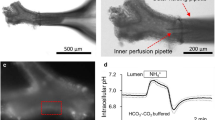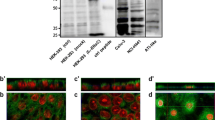Abstract
Purpose. To determine the functional presence of a H+/peptide cotransport process in rabbit tracheal epithelial cell layers cultured at an air-interface and its contribution to transepithelial dipeptide transport.
Methods. Rabbit tracheocytes were isolated, plated on Transwells, and cultured at an air-interface. After 5 or 6 days in culture, uptake and transepithelial transport of carnosine were examined.
Results. Carnosine uptake by tracheocytes was pH-dependent and was saturable with a Michaelis-Menten constant of 170 μM. Moreover, carnosine uptake was inhibited 94% by Gly-L-Phe, 28% by (β-Ala-Gly, but not at all by Gly-D-Phe or by the amino acids β-Ala and L-His. Unexpectedly, transepithelial carnosine transport at pH 7.4 (i.e., in the absence of a transepithelial pH gradient) was similar in both the apical-to-basolateral (ab) and basolateral-to-apical (ba) directions. Lowering the apical fluid pH to 6.5 reduced abtransport 1.6 times without affecting ba transport, consistent with predominantly paracellular diffusion of carnosine under an electrochemical potential gradient.
Conclusions. The kinetic behavior of carnosine uptake into cultured tracheal epithelial cell layers is characteristic of a H+-coupled dipeptide transport process known to exist in the small intestine and the kidney. Such a process does not appear to be rate-limiting in the transport of carnosine across the tracheal epithelial barrier.
Similar content being viewed by others
REFERENCES
T. Okano, K. Inui, H. Maegawa, M. Takano, and R. Hori. H+ coupled uphill transport of aminocephalosporins via the dipeptide transport system in rabbit intestinal brush-border membranes. J. Biol. Chem. 261:14130–14134 (1986).
A. Tsuji, I. Tamai, H. Hirooka, and T. Terasaki. Beta-lactam antibiotics and transport via the dipeptide carrier system across the intestinal brush-border membrane. Biochem. Pharmacol. 36:565–567 (1987).
H. Daniel and S. A. Adibi. Transport of β-lactam antibiotics in kidney brush border membrane: determinants of their affinity for the oligopeptide/H+ symporter. J. Clin. Invest. 92:2215–2223 (1993).
M. Hu and G. L. Amidon. Passive and carrier mediated intestinal absorption components of captopril. J. Pharm. Sci. 77:1007–1011 (1988).
W. Kramer, F. Girbig, U. Gutjahr, H. W. Kleeman, I. Leipe, H. Urbach, and A. Wagner. Interaction of renin inhibitors with the intestinal uptake system for oligopeptides and β-lactam antibiotics. Biochim. Biophys. Acta 1027:25–30 (1990).
P. A. Heilliwell, D. Merdith, C. A. R. Boyd, J. R. Bronk, N. Lister, and P. D. Bailey. Tripeptide transport in rat lung. Biochim. Biophys. Acta 1190:430–434 (1994).
D. Meredith and C. A. R. Boyd. Dipeptide transport characteristics of the apical membrane of rat lung type II pneumocytes. Am. J. Physiol. 269:L137–L143 (1995).
K. Morimoto, H. Yamahara, V. H. L. Lee, and K. J. Kim. Dipeptide transport across rat alveolar epithelial cell monolayers. Pharm. Res. 10:1668–1674 (1993).
R. G. Breeze and E. B. Wheeldon. The cells of the pulmonary airways. Am. Rev. Respir. Dis. 116:705–777 (1997).
S. I. Rennard, J. D. Beckmann, and R. A. Robbins. Biology of airway epithelial cells. In R. G. Crystal, J. B. West, P. J. Barnes, N. S. Cherniack, and E. R. Weibel (eds.), THE LUNG: Scientific Foundations, Raven Press, New York, 1991, pp. 157–167.
D. M. Matthews, J. M. Addison, and D. Burston. Evidence for active transport of the dipeptide carnosine (β-alanyl-L-histidine) by hamster jejunum in vitro. Clin. Sci. Mol. Med. 46:693–705 (1974).
V. Ganapathy and F. H. Leibach. Peptide transport in rabbit kidney: study with L-carnosine. Biochim. Biophys. Acta 691:362–366 (1982).
V. Ganapathy and F. H. Leibach. Role of pH gradient and membrane potential in dipeptide transport in intestinal and renal brushborder membrane vesicles from the rabbit: study with L-carnosine and glycyl-L-proline. J. Biol. Chem. 10:14189–14192 (1983).
V. M. Rajendran, A. Berteloot, Y. Ishikawa, A. H. Khan, and K. Ramaswamy. Transport of carnosine by mouse intestinal brush-border membrane vesicles. Biochim. Biophys. Acta 778: 443–448 (1984).
N. R. Mathias, T. W. Robison, K. J. Kim, and V. H. L. Lee. Development and characterization of rabbit tracheal epithelial cell culture models for drug transport studies. Pharm. Res. 12: 1499–1505 (1995).
K. Yamaoka, Y. Tanigawara, T. Nakagawa, and T. Uno. A pharmacokinetic analysis program (MULTI) for microcomputer. J. Pharmacobio-Dyn. 4:879–885 (1981).
F. Yamashita, K. J. Kim, and V. H. L. Lee. Gly-L-Phe transport and metabolism across primary cultured rabbit tracheal epithelial cell monolayers. Pharm. Res. 14:238–240 (1997).
H. Daniel, E. L. Morse, and S. A. Adibi. Determinants of substrate affinity for the oligopeptide/H+ symporter in the renal brush border membrane. J. Biol. Chem. 267:9565–9573 (1992).
M. Acevedo and L. W. Steele. Na+-H+ exchanger in isolated epithelial tracheal cells from sheep. Involvement in tracheal proton secretion. Exp. Physiol. 78:383–394 (1993).
A. M. Paradiso. Identification of Na+-H+ exchange in human normal and cystic fibrotic ciliated airway epithelium. Am. J. Physiol. 262:L757–L764 (1992).
J. G. Widdicombe. Airway mucus. Eur. Respir. J. 2:107–115 (1989).
M. Brandsch, C. Brandsch, M. E. Ganapathy, C. S. Chew, V. Ganapathy, and F. H. Leibach. Influence of proton and essential histidyl residues on the transport kinetics of the H+/peptide cotransport systems in intestine (PEPT 1) and kidney (PEPT 2). Biochim. Biophys. Acta 1324:251–262 (1997).
I. Naasani, K. Sato, K. Iseki, M. Sugawara, M. Kobayashi, and K. Miyazaki. Comparison of the transport characteristics of ceftibuten in rat renal and intestinal brush-border membranes. Biochim. Biophys. Acta 1231:163–168 (1995).
W. Liu, R. Liang, S. Ramamoorthy, Y. J. Fei, M. E. Ganapathy, M. A. Hediger, V. Ganapathy, and F. H. Leibach. Molecular cloning of PEPT 2, a new member of the H+/peptide cotransporter family, from human kidney. Biochim. Biophys. Acta 1235:461–466 (1995).
M. Boll, M. Herget, M. Wagener, W. M. Weber, D. Markovich, J. Biber, W. Clauss, H. Murer, and H. Daniel. Expression cloning and functional characterization of the kidney cortex high-affinity proton-coupled peptide transporter. Proc. Natl. Acad. Sci. USA 93:284–289 (1996).
H. Saito, T. Terada, M. Okuda, S. Sasaki, and K. Inui. Molecular cloning and tissue distribution of rat peptide transporter PEPT2. Biochim. Biophys. Acta 1280:173–177 (1996).
D. E. Goldman. Potential, impedance, and rectification in membranes. J. Gen. Physiol. 27:37–60 (1943).
K. Inui, M. Yamamoto, and H. Saito. Transepithelial transport of oral cephalosporins by monolayers of intestinal epithelial cell line Caco-2: Specific transport systems in apical and basolateral membranes. J. Pharmacol. Exp. Ther. 261:195–201 (1992).
S. Matsumoto, H. Saito, and K. Inui. Transcellular transport of oral cephalosporins in human intestinal epithelial cells, Caco-2: Interaction with dipeptide transport systems in apical and basolateral membranes. J. Pharmacol. Exp. Ther. 270:498–504 (1994).
Author information
Authors and Affiliations
Corresponding author
Rights and permissions
About this article
Cite this article
Yamashita, F., Kim, KJ. & Lee, V.H.L. Dipeptide Uptake and Transport Characteristics in Rabbit Tracheal Epithelial Cell Layers Cultured at an Air Interface. Pharm Res 15, 979–983 (1998). https://doi.org/10.1023/A:1011957506181
Issue Date:
DOI: https://doi.org/10.1023/A:1011957506181




